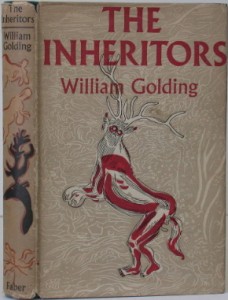Why did Golding decide to portray his Neanderthals as largely vegetarian?
The Neanderthal family group so vividly described in Golding’s 1955 novel are clearly happiest when eating a vegetarian diet. When they are at a near state of collapse through hunger, after making the long journey to their summer cave, they feast on the meat of a dead deer. Golding makes it clear that they only do so because it is already dead and ‘a cat has sucked all her blood’ and therefore ‘there is no blame.’ (p. 43)
Golding carefully relays his perception of Neanderthal man, and their diet is a recurring theme throughout the book that in many ways helps to develop their innocence. ‘Some of the fungi were good to eat and Lok gave these to Liku’ (p. 6); ‘they talked while they ate [leaves and shoots], brief ejaculations of pleasure and excitement’ (p. 38). By contrast, there is less enjoyment when presented with the meat of the deer: ‘the people are thin with hunger and they must eat. They do not like the taste of meat but they must eat.’(p. 46) Interestingly, this one foray into eating meat, both raw and cooked, encompasses the only true death scene from their family group – that of the old man Mal.
Juxtaposed against the Neanderthal’s innocence, is the violence of the new people (Homo sapiens) who have invaded the Neanderthal’s summer territory. Unlike the vegetarian Neanderthals, the new people are hunters and eat meat. They wield arrows, drink from containers made of skin, and wear skins and furs. In the case of the privileged female Vivani, Golding gives us a good description of her physical connection with hunting, as she ‘was covered with a magnificent skin, the cave-bear skin that had cost two lives to get.’ (p. 215) This theme of innocence through vegetarianism versus the violence of Homo sapiens the meat eater is exemplified by their cannibalising Liku (pp. 158-9). It is interesting to see how Golding manipulates our perceptions of these two different peoples, whether or not these depictions are true in a paleoanthropological sense.
Of course, Neanderthal, and early human theory (palaeoanthropology) is constantly evolving as more evidence is found and as the technology used to study it improves. Much theory came from the discovery in 1912 of fragmentary parts of a skull and jaw found in East Sussex. This find, hailed the ‘missing link’ was named Piltdown Man and led to scientific assumptions on our evolutionary beginnings. Although scientific opinions on our exact evolutionary process were divided, it did lead to questions of what it was to be human and often, the dynamics of the time were applied to scientific research.
Piltdown Man was reconstructed and portrayed as reassuringly masculine, with a heavyset body and masculine features. This reconstruction possibly reflected and defined contemporary perceptions of masculinity in the Edwardian era, just as Britain was about to enter The Great War. However, in 1953, two years before Golding wrote The Inheritors, Piltdown man was revealed to be a hoax.
So, why does Golding portray his Neanderthal people in a less masculine light? Vegetarianism by the 1950s had had an 80 or 90 year connection with political movements, such as feminism, and vegetarians often perceived themselves as having higher civilised values. Possibly, after WWII, Golding and his contemporaries perceived the battle for existence between the Neanderthal and Homo sapiens as a reflection of the German invasion during the war. Therefore, by presenting Neanderthal man with ‘feminising’ qualities, he created an innocent race juxtaposed by a violent and invading one; Homo sapiens.
Angela Websdale
2nd Year Undergraduate
Member of the ‘Twentieth Century Literature and Science: Remaking the Body’ module


Recent Comments